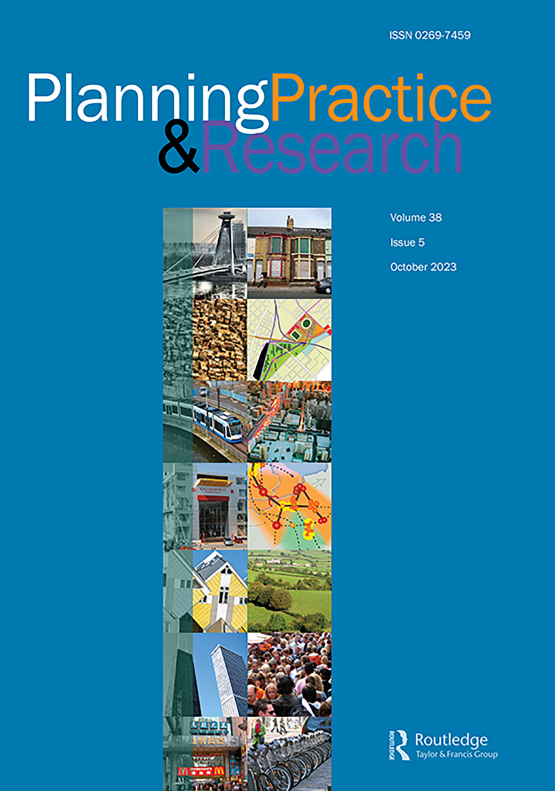Submit a Manuscript to the Journal
Planning Practice & Research
For a Special Issue on
X-minute cities and the focus on accessibility: perspectives from social-ecological urbanism
Abstract deadline
31 January 2024
Manuscript deadline
30 September 2024

Special Issue Editor(s)
Nancy Joy Lim,
University of Gävle, Sweden
[email protected]
Åsa Gren,
University of Gävle, Sweden
[email protected]
X-minute cities and the focus on accessibility: perspectives from social-ecological urbanism
This proposal for a special issue is borne out of discussions during and after the Third Symposium on Social-Ecological Urbanism, held at University of Gävle on December 8, 2022, entitled Nested scales on urban form and green urban infrastructure.
Social-ecological urbanism is an emerging discourse on sustainable urban development, with a focus on how urban form, urban green infrastructure and institutions can promote human well-being and resilient cities. Seeing cities as interlinked social-ecological systems, it offers a broad account of sustainable urban development encompassing the interplay between ‘fast’ urban landscapes of centrality, connectivity and accessibility and ‘slow’ urban landscapes of (human and ecological) resilience and regeneration.
The Third Symposium on Social-Ecological Urbanism focused on the increasing attention to the role of urban form for making cities more liveable and inclusive, and for mitigating climate change by promoting walking and biking. A prime example of this increasingly popular theme in urban planning and sustainability, centered around accessibility, is the concept of the 15-minute city. The 15-minute city refers to a vision of the city, where inhabitants can cover the majority of their daily needs within a 15-minute transportation radius. Popularised by the Mayor of Paris as a political vision, it is now increasingly making its way into scientific conferences and research funding calls. Along the same lines, cities around the world are branding themselves as current or future 20-minute, 10-minute and even 5-minute cities, a phenomenon sometimes branded ‘the x-minute city’.
However, it is often overlooked that time and space are not the same. Thus, it is unclear what urban landscapes and urban forms such visions of accessibility represent, as it can be relative to how it is contextualised and defined from the planning perspective. This, therefore, can lead to questions such as: do they evoke images of ‘fast’ urban landscapes of centrality and ever-increasing connectivity? Or do they symbolize ‘slow’ urban landscapes with an emphasis on the local scale and non-motorized modes of transportation? Is it desirable to get the x in ‘the x-minute city’ as small as possible, from environmental as well as social points of view? The answers to these questions matter for how accessibility can be reconciled with other important imperatives for urban sustainability planning, like long-term resilience and regeneration.
This special issue invites authors to engage with such questions using the lens of social-ecological urbanism. Topics that could be explored include, but are not limited to:
- Pros and cons of increasingly popular urban sustainability and planning concepts like the 15-minute city, and the added value (or lack thereof) of their increasing popularity.
- Areas of synergy and of conflict between achieving ‘fast’ urban landscapes of connectivity and ‘slow’ urban landscapes of resilience and regeneration, and ways forward for reconciling conflicts.
- The integration of ecological systems in different accessibility contexts in planning, including their significance to attaining resilience, enabling human-nature interaction, and promoting health and well-being of individuals.
- Ways for making increased urban accessibility and a local scale focus contribute to carbon neutrality (e.g. policies on material usage and circulation, nature-based solutions, or energy prosumers).
- Involvement of residents and social inclusion for deciding what ought to constitute livable and inclusive urban landscapes, and how these can be integrated into planning.
- Embedding environmental design perspectives in urban landscapes, and in urban/spatial planning (e.g. design principles, best practice examples, and issues for implementation).
Looking to Publish your Research?
Find out how to publish your research open access with Taylor & Francis Group.
Choose open accessSubmission Instructions
We welcome original research, practice review articles, case studies, and methodologies or methods articles related to the specified topics of this special issue.
A 250-word abstract providing a brief summary of the content of the proposed paper should be sent to the special issue editors (Nancy Joy Lim, [email protected]). The editors will select and invite submissions from the submitted abstracts.
All full papers must be submitted to the special issue editor (Nancy Joy Lim, [email protected]) for consideration before they are submitted to the journal through the website. The editor will review the paper and agree submission or ask for revisions. When original research papers are submitted to the journal they will be subject to double anonymous peer-review. Other practice review papers or case reports will be subject to review by the editors with assistance from the editorial board and independent reviewers where necessary.
Original research papers should be no longer than 7,000 words excluding figures and references. Papers will be published online as soon as accepted. For further details on requirements see information for authors on the journal website.